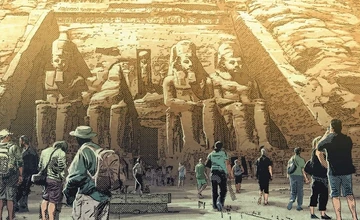radicalthought.org – The Great Temple of Ramses II at Abu Simbel is one of the most iconic monuments of ancient Egypt. Built by one of Egypt’s most celebrated pharaohs, this temple is a testament to the grandeur, power, and architectural ingenuity of the ancient Egyptians.
Historical Background
The Great Temple was commissioned by Pharaoh Ramses II, who ruled Egypt from 1279 to 1213 BCE. It was constructed in Nubia, a region that was strategically important for Egypt’s expansion and control over trade routes. The temple was intended to showcase Ramses II’s power and to honor the gods, notably Ra-Horakhty, Amun, and Ptah.
Architectural Features
The temple is renowned for its monumental facade, which features four colossal statues of Ramses II seated on his throne. Each statue is approximately 20 meters high, symbolizing the pharaoh’s divine status and strength. The facade is carved directly into the rock, exemplifying the skill and artistry of ancient Egyptian craftsmen.
Inside the temple, a series of halls and chambers are adorned with intricate carvings and hieroglyphics. These artworks depict scenes of Ramses II’s military victories, religious ceremonies, and interactions with the gods. The inner sanctuary houses statues of Ramses II and the triad of gods, and is designed so that twice a year, the sun illuminates the statues, a phenomenon that underscores the ancient Egyptians’ advanced understanding of astronomy.
Cultural and Religious Significance
The Great Temple of Ramses II was both a political symbol and a religious center. It was intended to reinforce Ramses II’s divine status and to demonstrate his benevolence and power, both to his subjects and to neighboring regions. The temple served as a place of worship and as a reminder of the pharaoh’s eternal presence and divine favor.
Modern-Day Preservation
In the 1960s, the construction of the Aswan High Dam threatened to submerge the temple under the waters of Lake Nasser. An international campaign, led by UNESCO, successfully relocated the temple to a higher location, preserving it for future generations. This monumental effort involved cutting the temple into large blocks and painstakingly reconstructing it, ensuring its survival as a UNESCO World Heritage site.
Conclusion
The Great Temple of Ramses II is a masterpiece of ancient Egyptian architecture and a symbol of the pharaoh’s enduring legacy. Its majestic statues, intricate carvings, and historical significance continue to captivate visitors from around the world, offering a glimpse into the splendor and sophistication of ancient Egyptian civilization.
